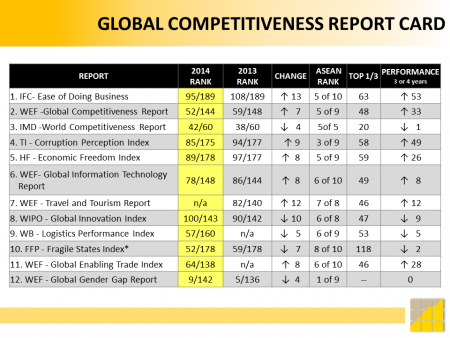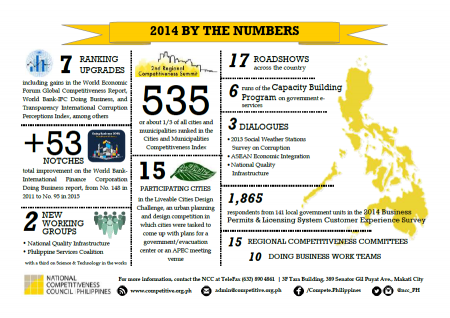- Home
- |
- About Us
- |
- Working Groups
- |
- News
- |
- Rankings
- WEF-Global Competitiveness Report
- Ease of Doing Business Report
- IMD-World Competitiveness Yearbook
- TI-Corruption Perceptions Index
- HF-Economic Freedom Index
- WEF-Global Information Technology Report
- WEF-Travel and Tourism Report
- WIPO-Global Innovation Index
- WB-Logistics Performance Index
- FFP-Fragile States Index
- WEF-Global Enabling Trade Report
- WEF-Global Gender Gap Report
- Gallery
- |
- Downloads
- |
- Contact Us
Statement of the National Competitiveness Council for Year End 2014
As the year draws to a close, the National Competitiveness Council is pleased to report on some of the highlights of the year as well as some upcoming projects.
2013 was a breakthrough year for the Philippines, which registered gains in seven out of eight major global competitiveness reports. In 2014, we expanded our list to cover more reports in an effort to more effectively diagnose areas that need improvement.
We have kept the momentum going in seven out of twelve reports, but have noted some setbacks in five. Among the seven, the Philippines has posted the biggest improvements in ASEAN over three years in the World Economic Forum Global Competitiveness Report (+33) and Global Enabling Trade Report (+28), World Bank-International Finance Corporation Doing Business Report (+53), Transparency International Corruption Perceptions Index (+49), and the Heritage Foundation Economic Freedom Index (+26). The declines, on the other hand point, to the need for improvements in areas like infrastructure, education, research and development, and disaster response.

While our existing working groups continue to address such issues, we have organized new groups on National Quality Infrastructure and Services to bring our exports and services sectors to address issues and accelerate gains in those sectors. A new group on Science and Technology is also being set up to close the innovation gap.
As seen in our Task Force on Doing Business, public-private collaboration can be an effective driver of change and we hope to bring about even more reform through this formula, especially as changes in the methodology of competitiveness reports set off even tougher challenges ahead.
Running in parallel with these sector-wide programs are our local competitiveness initiatives. This year, our Regional Competitiveness Committees released the Cities and Municipalities Competitiveness Index covering 535 LGUs, giving businessmen and citizens an objective and quantitative measure of performance. Next year, we will push the envelope and add even more LGUs, bringing our total coverage to over 1,000.
To encourage cities to plan and design for resilience and liveability, we also launched the Liveable Cities Design Challenge, an urban planning and design competition. Mentored by architects and urban planners, 15 participating cities delivered designs for a government/evacuation center and an APEC meeting venue. This is the first step towards mainstreaming principles of liveable, resilient, sustainable, and competitive growth.
Perhaps the year is best summarized in the findings of the Worldwide Governance Indicators. Though the country has shown vast improvement in aggregate indicators like Control of Corruption and Political Stability and Absence of Violence, we started from such a low base that we must accelerate our growth rates to overtake our competitors. On the other hand, we have begun to show signs of stagnation on indicators measuring Government Effectiveness, illustrating that we need to renew efforts to deliver public services better.
Already we have begun to lay the groundwork on certain projects that will institutionalize good governance practices. First, in line with our hosting of APEC this 2015, we have launched the Islands of Good Governance campaign with the Institute of Solidarity in Asia. What started out as a balanced scorecard system for six agencies has grown to more than 20 national government agencies and local government units subjecting themselves to external audits. We aim to showcase these audited breakthrough results in 2015 as proof of our commitment to good governance.
Second, while we continue to hold our officials accountable for performance, we have realized that certain policies at the national, departmental, and local levels have made it difficult to reduce the cost of compliance and enforcement and consequently hinder efficient public service delivery. We are currently studying an idea called “Project Repeal” to identify outdated laws that are long due for repeal and plan to organize a team to facilitate its implementation in partnership with Congress.
All these projects come into full circle with our stakeholder engagement campaigns like our dialogues and roadshows and our monitoring and evaluation tools, which include the Annual Enterprise Survey on Corruption by the Social Weather Stations and the Business Permits and Licensing System Customer Experience Survey.
By institutionalizing and publishing these performance metrics, we hope to instill a culture of competitiveness and benchmarking among government offices. More importantly, we hope to provide Filipinos with performance standards for government service. With information on what to expect from government, the public will be empowered to assess performance and demand for better. Ultimately, this competitive mindset is what will drive the Philippines to the top third of global rankings.
We thank those who have supported our vision through the years and we look forward to working with even more partners in the future.
Download the presentation at http://www.competitive.org.ph/downloads/1057


